You’ll find that Hawaii’s native plants exist across ten distinct climate zones within just a few square miles, creating more biodiversity per acre than most entire countries. When you explore these islands, you’re witnessing 90% endemic species that evolved in complete isolation over millions of years. From sea-level naupaka with its half-moon flowers to alpine silverswords surviving at 10,000 feet, each plant tells a survival story that’ll completely change how you view island gardening.
Contents
- 1 Hawaii’s Diverse Microclimates and Elevations
- 2 Endemic Hawaiian Flowering Species
- 3 Hawaiian Canopy Trees Selection
- 4 Hawaiian Understory Shrub Varieties
- 5 Selecting the Right Native Plants for Your Garden
- 6 Frequently Asked Questions
- 6.1 How Do Hawaiian Native Plants Survive Volcanic Soil Conditions?
- 6.2 What Role Do Native Birds Play in Hawaiian Plant Pollination?
- 6.3 Are Hawaiian Native Plants Resistant to Invasive Species Threats?
- 6.4 How Has Climate Change Affected Hawaiian Native Plant Populations?
- 6.5 Can Hawaiian Native Plants Be Grown Successfully Outside of Hawaii?
Hawaii’s Diverse Microclimates and Elevations
How can a tropical paradise contain everything from desert wastelands to near-polar conditions within just a few miles? You’ll find the answer in Hawaii’s remarkable elevation influences, which create ten distinct climate zones across the islands.
As you climb from sea level to Mauna Kea’s 13,796-foot summit, temperatures drop roughly 3°F per 1,000 feet. These dramatic microclimate variations occur because trade winds carry moisture up windward slopes, creating lush conditions below 8,000 feet, while leeward sides remain desert-dry. Above the inversion layer, you’ll discover stone deserts where ice persists in volcanic craters.
The most extreme cold occurs not at the highest peaks, but in volcanic craters where cold air becomes trapped overnight, creating temperature inversions that can reach as low as -20°C even in this tropical setting.
Endemic Hawaiian Flowering Species
Hawaii’s endemic flowering plants represent extraordinary evolutionary adaptations, including native hibiscus species, diverse lobelioid radiations, Hawaiian raspberries, critically endangered rarities, and unique genera found nowhere else on Earth. Many of these remarkable species face conservation challenges due to habitat loss and invasive species threatening their survival.
Hawaiian Hibiscus (Hibiscus Brackenridgei)
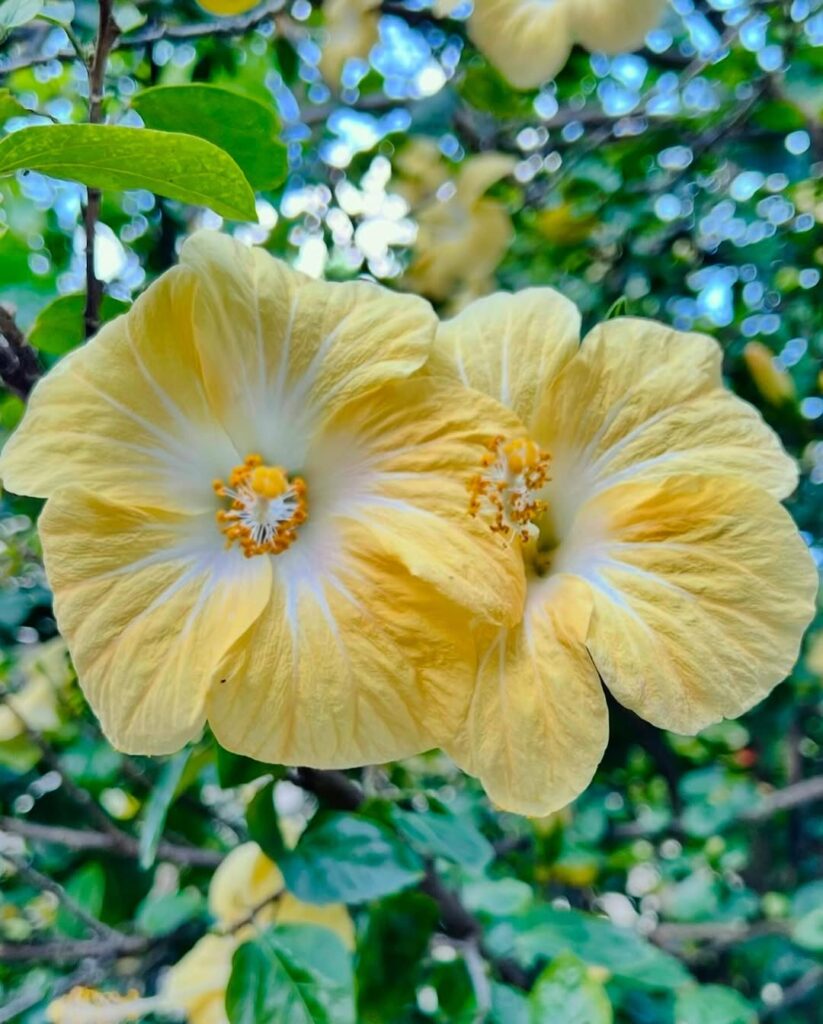
Hawaiian Hibiscus (Hibiscus brackenridgei) is Hawaii’s official state flower and a critically endangered endemic species found only on the Hawaiian islands. This sprawling shrub or small tree of the mallow family produces distinctive bright yellow flowers with five petals and often features red or maroon centers. Growing up to 16 feet tall, it naturally inhabits lowland dry to mesic forests from sea level to 1,200 feet elevation.
With fewer than 60 plants remaining in the wild across just seven populations, this rare native species faces severe threats from habitat destruction, invasive species, and feral animals. Known locally as “ma’o hau hele,” it blooms sporadically with peak periods in spring and winter, producing oval seed capsules containing kidney-shaped seeds. The leaves have a distinctive sandpaper-like feel with a medium to coarse texture and range from 2 to 6 inches long.
- Hardiness: USDA zones 10-12, endemic to Hawaiian lowlands
- Light: Full sun to partial shade
- Water: Low to moderate water needs, drought-tolerant once established
- Soil: Well-draining soils, adapts to various soil types in dry to mesic conditions
- Fertilizer: Low fertility requirements, minimal fertilization needed
- Pest/Disease Resistance: Vulnerable to damage from feral animals and invasive plant competition
- Growth Rate: Moderate growth rate, long-lived perennial species
Hawaiian Tree Cotton (Kokio)
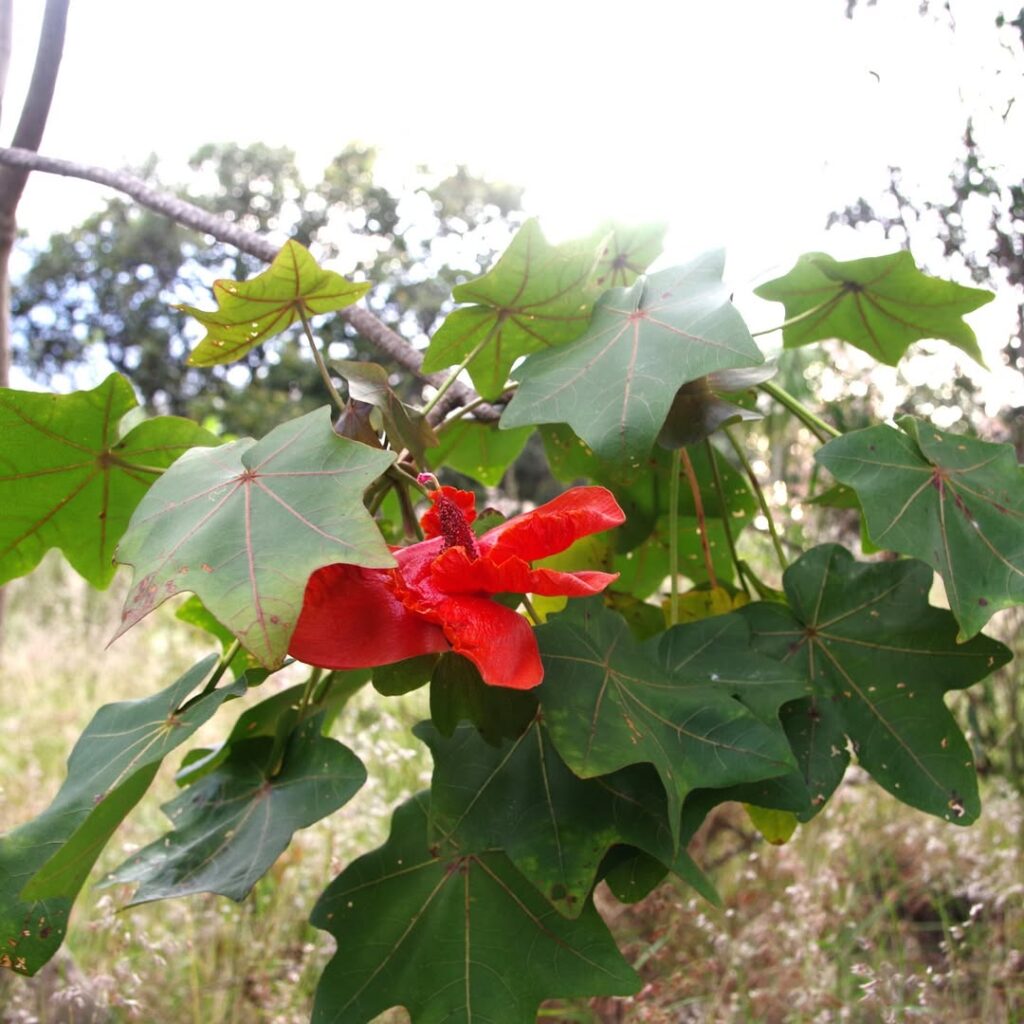
Kokia drynarioides, known as Hawaiian tree cotton or koki’o, is a critically endangered endemic species belonging to the mallow family. This deciduous tree produces large, showy flowers and grows naturally only on the Big Island of Hawaii’s volcanic terrain. With fewer than ten trees remaining in the wild, it represents one of Hawaii’s rarest native plants.
Traditionally valued by native Hawaiians for its red dye-producing sap and medicinal bark, this species has deep cultural significance. The plant’s decline has also impacted endangered Hawaiian honeycreepers that depend on its nectar, highlighting its ecological importance in Hawaii’s native ecosystems. The species is classified within the Gossypieae tribe and has been extensively documented in various botanical databases for conservation research.
- Hardiness: USDA zones 10-11, adapted to volcanic terrain at elevations 455-1915 meters
- Light: Full sun to partial shade in native dry forest conditions
- Water: Low to moderate water needs; drought-tolerant once established
- Soil: Well-draining volcanic soil; thrives in thin, highly drained lava-based substrates
- Fertilizer: Minimal fertilizer requirements; adapted to nutrient-poor volcanic soils
- Pest/Disease Resistance: Susceptible to introduced pests and diseases affecting native Hawaiian flora
- Growth Rate: Slow to moderate growth rate typical of native Hawaiian dry forest species
Naupaka (Scaevola Taccada)
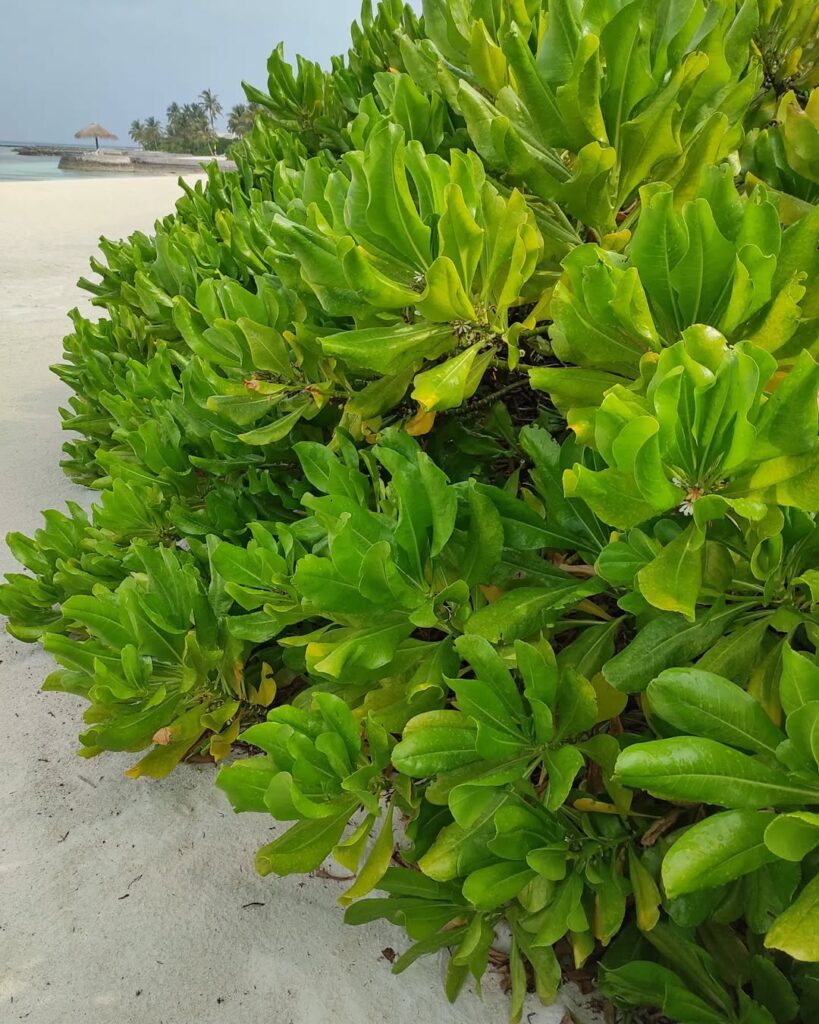
Naupaka kahakai (Scaevola taccada) is a distinctive coastal shrub native to Hawaiian beaches, reaching 3-10 feet tall with characteristic succulent, oval leaves and unique half-flowers with fused pinkish-white petals. This hardy species produces white drupes and features silky white hairs between stems and branches, making it easily recognizable along coastlines.
The plant’s buoyant seeds remain viable for approximately 250 days in ocean currents, enabling natural dispersal throughout the Indo-Pacific region. Traditionally valued for multiple uses including lei-making, skin treatments, and emergency food, naupaka serves important ecological functions as a natural beach stabilizer in its native Hawaiian ecosystem. The shrub also attracts pollinators like bees and butterflies, contributing to coastal biodiversity.
- Hardiness: USDA zones 10-12, salt and wind tolerant
- Light: Full sun to partial shade
- Water: Low to moderate, drought tolerant once established
- Soil: Sandy, well-draining coastal soils, salt tolerant
- Fertilizer: Low requirements, occasional slow-release fertilizer
- Pest/Disease Resistance: Generally resistant to most pests and diseases
- Growth Rate: Moderate to fast, 1-2 feet per year
Hawaiian Silversword (Argyroxiphium)

The Hawaiian Silversword (Argyroxiphium) is an iconic endemic plant forming distinctive globe-shaped rosettes with sword-like, silver-haired leaves. Found exclusively at high elevations on Maui’s Haleakalā and Hawaiʻi Island’s Mauna Loa, these remarkable plants can live for decades before producing a spectacular flowering stalk reaching up to 9 feet tall with hundreds of pink to wine-red flowers.
These monocarpic plants flower only once before dying, making their dramatic blooming period in summer particularly precious. Known locally as ʻāhinahina, silverswords are critically endangered with fewer than 1,000 Mauna Loa silverswords remaining in the wild, threatened by invasive species, feral animals, and human disturbance. The introduction of foreign hoofed mammals by European colonizers has been a key factor in the decline of silversword populations.
- Hardiness: Adapted to harsh alpine desert conditions at 6,900-9,800 feet elevation; extremely cold and heat tolerant but specific to Hawaiian high-elevation microclimates
- Light: Full sun; adapted to intense UV radiation at high altitudes
- Water: Extremely drought tolerant; adapted to low precipitation alpine desert environments with excellent drainage
- Soil: Well-draining rocky volcanic soils; thrives in nutrient-poor, acidic substrates with excellent drainage
- Fertilizer: Not applicable in natural habitat; adapted to nutrient-poor volcanic soils without supplementation
- Pest/Disease Resistance: Generally resistant to pests and diseases but vulnerable to damage from feral animals like goats
- Growth Rate: Extremely slow; requires decades to mature before single flowering event
Maui’s Endemic Tarweed (Dubautia)
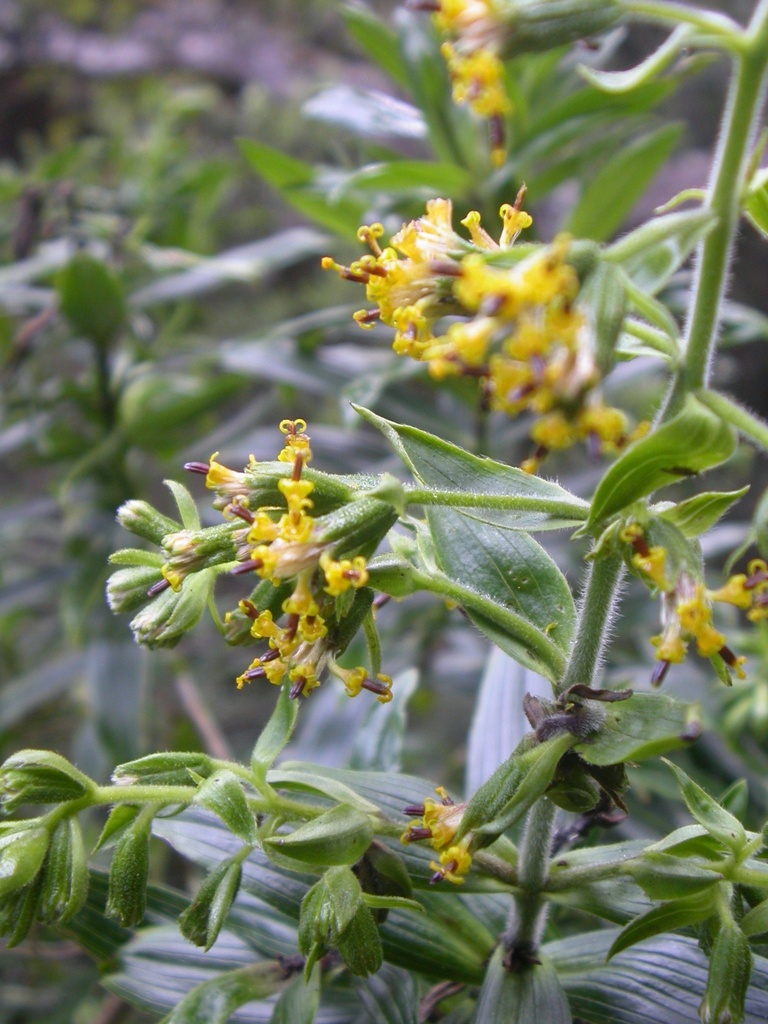
Maui’s endemic Dubautia species represent remarkable examples of adaptive radiation within the Hawaiian silversword alliance. These perennial flowering plants have evolved into diverse forms ranging from small shrubs to woody vines, each adapted to specific ecological niches across the island’s varied landscapes. With their characteristic yellow flower heads and distinctive morphological traits, these rare endemic tarweeds demonstrate the extraordinary evolutionary processes that have shaped Hawaii’s unique flora.
Several Dubautia species are restricted to Maui’s remote ridgelines, wet forests, and bog environments, making them highly vulnerable to habitat loss and invasive species. Their specialized adaptations to harsh, isolated conditions showcase millions of years of evolution, yet many populations exist in only a few known clusters, requiring urgent conservation attention to prevent extinction. The entire silversword alliance radiated from a common ancestor approximately 5.2 million years ago, highlighting the relatively recent but rapid diversification of these remarkable Hawaiian endemics.
- Hardiness: USDA zones 10-11, adapted to tropical Hawaiian conditions
- Light: Full sun to partial shade depending on species and native habitat
- Water: Varies by species; some prefer consistently moist bog conditions, others tolerate drought
- Soil: Well-draining volcanic soils; some species adapted to nutrient-poor substrates
- Fertilizer: Low to no fertilizer requirements; adapted to native nutrient-poor conditions
- Pest/Disease Resistance: Generally resistant to native pests but vulnerable to introduced species
- Growth Rate: Slow to moderate, typical of endemic Hawaiian woody plants
Hawaiian Canopy Trees Selection
Hawaiian canopy trees form the backbone of island forests, from towering koa in upland zones to resilient ‘ōhi’a across diverse elevations, each species uniquely adapted. The majestic Acacia koa has been historically used for crafting traditional canoe logs, making it one of the most culturally significant trees in Hawaiian forests.
Koa (Acacia Koa)
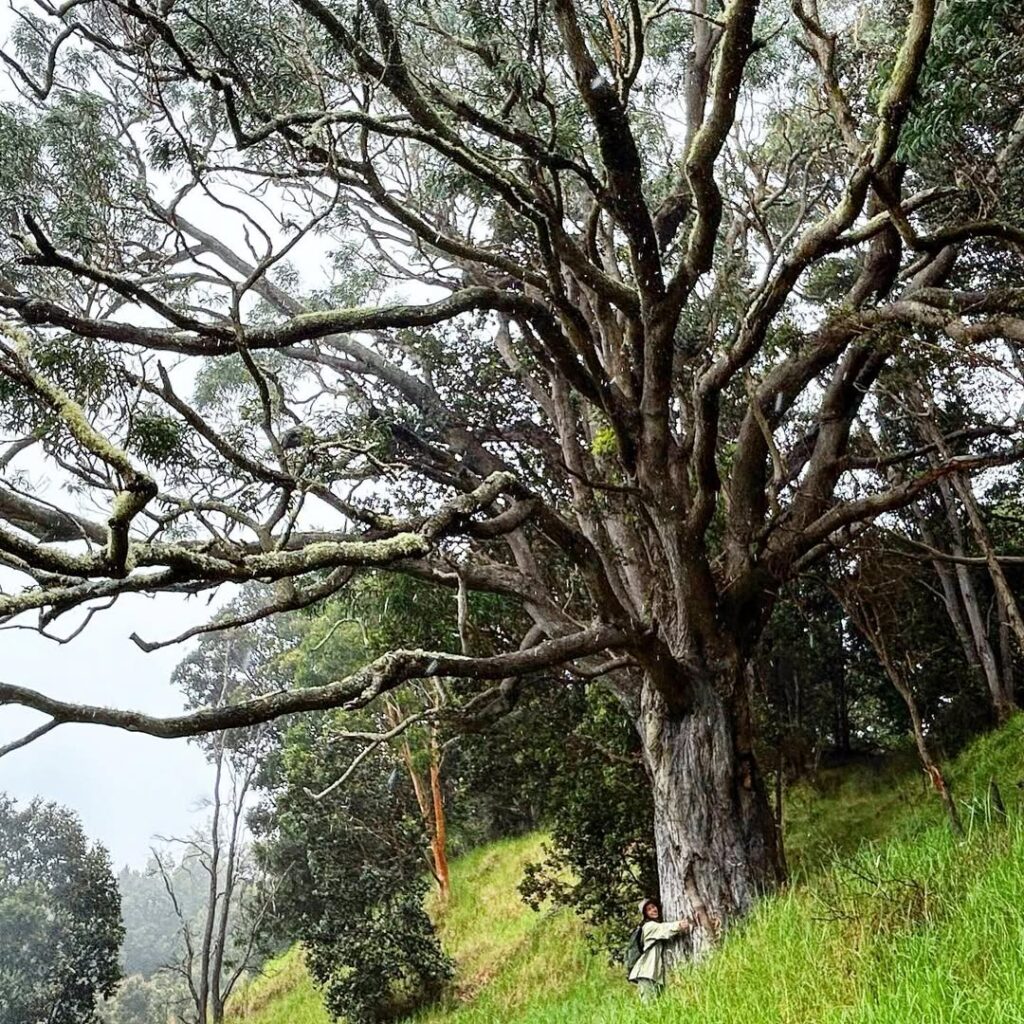
Koa (Acacia koa) is Hawaii’s most culturally significant tree, revered by early Hawaiians for crafting dugout canoes and prized today as “Hawaiian mahogany.” This endemic species is the largest native Hawaiian tree, capable of reaching 115 feet in height with distinctive sickle-shaped phyllodes. Found across all main islands with three distinct varieties, koa wood displays beautiful grain patterns in red, golden brown, and brown shades, making it one of the world’s most expensive woods due to limited supply and high demand. The tree enhances growth through symbiosis with rhizobia, nitrogen-fixing bacteria that benefit both the koa and surrounding native plants.
- Hardiness: Zones 10-12, tolerates elevations from 80-8,000 feet
- Light: Full sun to partial shade
- Water: Moderate; thrives in dry to moist conditions
- Soil: Well-draining soils, adaptable to various soil types at different elevations
- Fertilizer: Low requirements once established; benefits from minimal supplemental feeding
- Pest/Disease Resistance: Susceptible to koa moth, twig borers, fungi, and koa wilt disease
- Growth Rate: Fast-growing, approximately 5 feet per year for first five years
Hawaiian Sandalwood (Santalum)

Hawaiian sandalwood (Santalum spp.) represents a collection of endemic species unique to each major Hawaiian island. These aromatic trees and shrubs, known as ʻiliahi in Hawaiian, are semi-parasitic plants that attach their roots to neighboring vegetation while also photosynthesizing independently. Historically prized for their fragrant heartwood used in carving, medicine, and ceremonial purposes, these culturally significant trees were nearly decimated by 19th-century overharvesting.
Today, Hawaiian sandalwood species vary considerably in size and habitat preferences. Coastal varieties like Santalum ellipticum thrive in arid, salt-laden environments, while others prefer different elevations and moisture levels. Their small, star-shaped flowers bloom in various colors from spring through fall, eventually producing purple or black drupes that feed native wildlife. For optimal health and growth, these plants require host plants such as koa, koaia, or naio for their semi-parasitic relationship.
- Hardiness: Zones 9-11, highly drought-tolerant once established with host plants
- Light: Full sun to partial shade depending on species
- Water: Low to moderate; extremely drought-tolerant when parasitically connected to hosts
- Soil: Well-draining soils; coastal species tolerate poor, rocky, or sandy conditions
- Fertilizer: Minimal requirements due to semi-parasitic nature obtaining nutrients from host plants
- Pest/Disease Resistance: Generally resistant when healthy, though vulnerable to habitat degradation
- Growth Rate: Slow to moderate, 2-50+ feet depending on species
Ohia Lehua (Metrosideros)
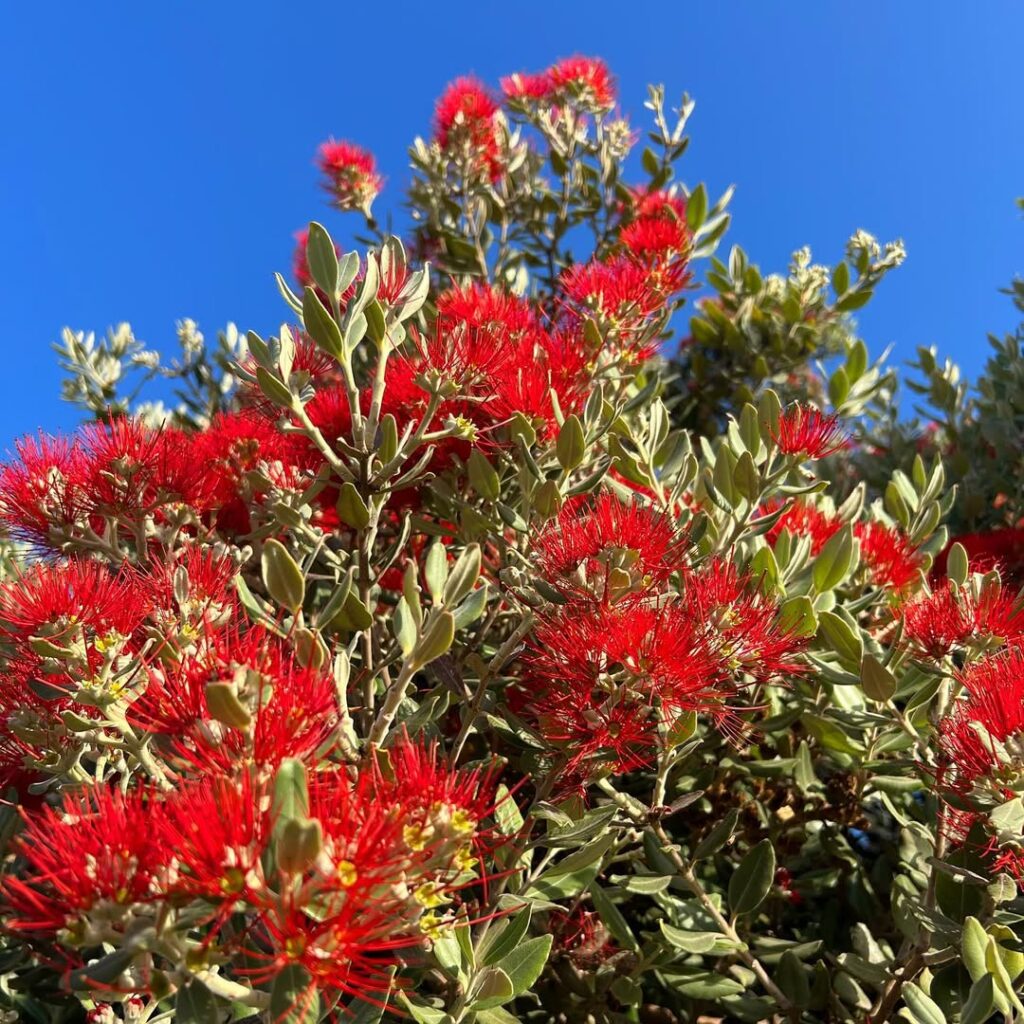
Metrosideros polymorpha, known as ʻŌhiʻa lehua, is Hawaii’s most widespread native tree, comprising approximately 80% of the islands’ native forests. This remarkably adaptable species lives up to its name “polymorpha” (many forms), growing as prostrate shrubs to towering 100-foot trees across diverse Hawaiian landscapes.
The species produces stunning flower displays of brilliant red to yellow stamens and features smooth, ovate leaves with distinctive stilt roots in forest environments. As a pioneer colonizer of fresh lava flows, ʻŌhiʻa lehua demonstrates extraordinary resilience while forming the backbone of Hawaiian ecosystems from sea level to treeline. This endemic species is found on all main islands except Niihau and Kahoolawe, establishing itself in nearly every Hawaiian ecosystem.
- Hardiness: USDA zones 9-11, tolerates temperatures from tropical to cool mountain conditions
- Light: Full sun to partial shade, adapts to various light conditions from open lava fields to forest understory
- Water: Extremely adaptable, thrives in 400mm to over 10,000mm annual rainfall
- Soil: Acidic to neutral soils (pH 3.6-7.4), tolerates various types including volcanic, Histosol, and Mollisol
- Fertilizer: Low nutrient requirements, adapted to nutrient-poor volcanic soils
- Pest/Disease Resistance: Susceptible to Rapid Ohia Death (ROD), otherwise generally resistant
- Growth Rate: Variable, slow to moderate depending on environmental conditions
Hawaiian Wiliwili Tree (Erythrina)

The Hawaiian Wiliwili tree (Erythrina sandwicensis) is the only endemic Hawaiian member of the globally widespread Erythrina genus, serving as a keystone species in the islands’ dry lowland forests. This deciduous tree reaches 35-45 feet tall and features defensive spines, compound leaves with three rounded leaflets, and distinctive seed pods containing orange-red or yellow seeds.
Historically dominant across Hawaiian dryland ecosystems, wiliwili has significant cultural importance, with Native Hawaiians using its lightweight wood for fishing floats, outrigger canoe components, and royal surfboards. The tree’s unique bird pollination adaptations include horizontal flower racemes and erect floral standards that attract native Hawaiian birds during its blooming season. Though nearly extinct due to invasive gall wasp damage, conservation efforts have helped stabilize populations, though the species remains vulnerable to ongoing threats including habitat loss and invasive species competition.
- Hardiness: USDA zones 10-12, tolerates extreme heat and drought conditions
- Light: Full sun exposure, adapted to intense tropical sunlight
- Water: Low water requirements, drought-tolerant once established, summer-dormant during dry periods
- Soil: Well-draining soils, tolerates poor volcanic soils and rocky substrates
- Fertilizer: Minimal requirements due to nitrogen-fixing capabilities as legume family member
- Pest/Disease Resistance: Vulnerable to gall wasp infestations, requires biocontrol management
- Growth Rate: Moderate growth rate, easily propagated from cuttings
Hawaiian Kopiko (Psychotria)

Hawaiian Kopiko (Psychotria) encompasses about 11 native species in Hawaii’s coffee family, forming an important component of wet forest canopies. These endemic trees and shrubs range from small specimens to mature trees reaching 45 feet tall, characterized by distinctive shiny leaves with glandular lines along their central veins and bright orange oval fruits.
The genus represents remarkable island evolution, with species like Psychotria hawaiiensis (kōpiko ʻula) distinguished by reddish-brown hairs and Psychotria grandiflora featuring white flower clusters. These native trees provide essential food sources for endemic Hawaiian birds like the ʻōmaʻo thrush, while historically serving Hawaiians as tool-making wood and fuel. The botanical classification includes Psychotria mariniana as one of the recognized species within this diverse Hawaiian genus.
- Hardiness: USDA zones 10-12, adapted to tropical Hawaiian climate conditions
- Light: Partial shade to filtered sunlight, thrives under forest canopy
- Water: High moisture requirements, consistent rainfall or irrigation needed
- Soil: Rich, well-draining volcanic soils with high organic matter content
- Fertilizer: Minimal requirements when grown in native forest conditions
- Pest/Disease Resistance: Generally resistant to most pests in native habitat
- Growth Rate: Moderate to slow, varies by species from shrub to large tree form
Hawaiian Understory Shrub Varieties
Hawaiian understory shrubs form essential ecosystem layers, ranging from common versatile species to rare specialized varieties, each contributing unique ecological functions and conservation value. These native species demonstrate remarkable growth diversity, with some like Aalii forming dense 4-8 foot shrubs while others like Akia grow prostrate along the ground.
Hawaiian Pilo (Coprosma)
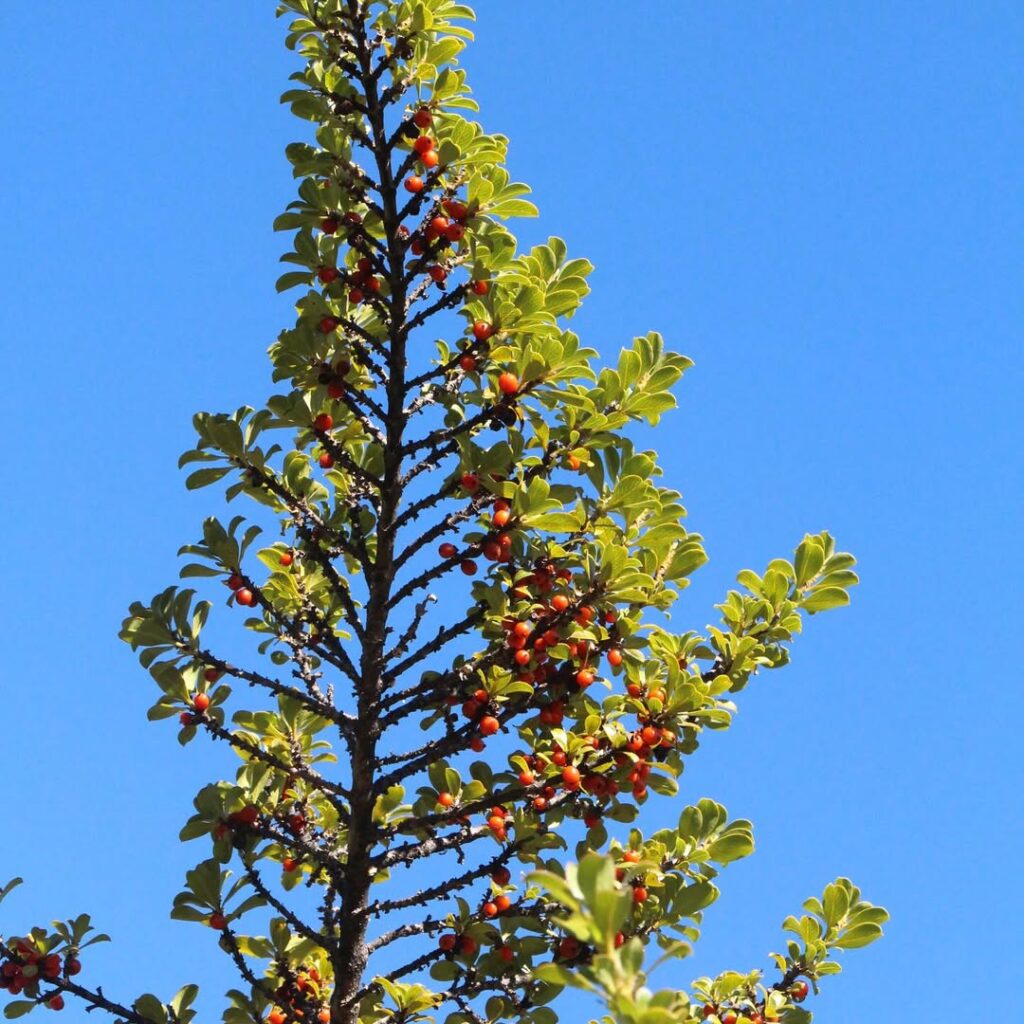
Hawaiian Pilo comprises thirteen endemic Coprosma species belonging to the coffee family, distributed across multiple Hawaiian islands. These understory shrubs and small trees thrive in mesic to wet forests from lowland to high elevations, commonly between 2,500-10,000 feet. Notable for their distinctive “rotten cabbage” odor when crushed, these plants produce heart-shaped fruits in various colors that serve as important food sources for native birds like the ʻōmaʻo.
Species exhibit remarkable diversity in leaf forms and habitat preferences, from bog environments to subalpine woodlands. Ancient Hawaiians utilized the berries medicinally as laxatives, while modern applications focus on native landscaping and habitat restoration. All species feature inconspicuous flowers on separate male and female plants, followed by attractive fruit displays that enhance their value in conservation plantings. Coprosma rhynchocarpa produces distinctive oval-shaped fruits that resemble small paint brushes with pointed ends.
- Hardiness: Adapted to harsh mountain conditions including drought and wind exposure
- Light: Partial shade to filtered sunlight in understory environments
- Water: Moderate to high moisture; thrives in mesic to wet conditions
- Soil: Well-drained substrates including cinder, organic matter, and volcanic soils
- Fertilizer: Low nutrient requirements; adapted to native volcanic soils
- Pest/Disease Resistance: Generally hardy with few recorded pest issues
- Growth Rate: Slow to moderate growth typical of native Hawaiian shrubs
Hawaiian Aalii Bush (Dodonaea)
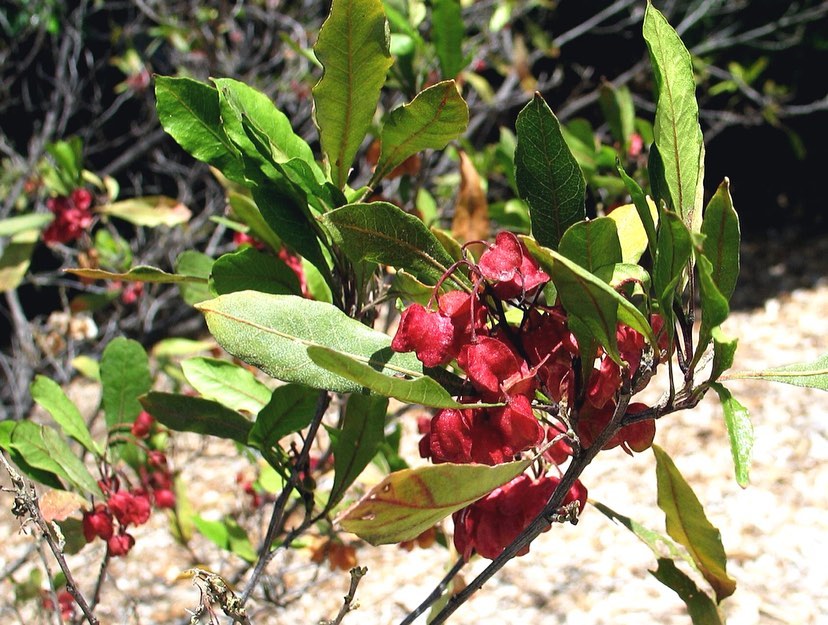
The Hawaiian Aalii bush (Dodonaea) is a highly adaptable native shrub that grows 6-12 feet tall, though it can reach up to 25 feet. This versatile plant exhibits remarkable variation in form and leaf characteristics, with sticky, narrow leaves that may display reddish hues. Distinguished by its winged seed capsules, aalii serves as an excellent early colonizer in ecological restoration.
Renowned for its exceptional drought tolerance and wind resistance, aalii thrives across diverse Hawaiian habitats from sea level to subalpine elevations. Its deep taproot system provides excellent erosion control while requiring minimal maintenance once established. Traditionally valued for tool-making and ceremonial uses, this resilient shrub symbolizes strength and adaptability in Hawaiian culture. The hard wood is so dense it actually sinks in water, making it prized for durable construction and traditional weapons.
- Hardiness: USDA zones 10-12, tolerates temperatures down to 30°F
- Light: Full sun to partial shade; thrives in bright, exposed conditions
- Water: Low to moderate; drought tolerant once established, minimal irrigation needed
- Soil: Well-draining soils; adapts to rocky, sandy, or clay substrates; pH tolerant
- Fertilizer: Low maintenance; benefits from occasional organic matter but not required
- Pest/Disease Resistance: Excellent; naturally resistant to most pests and diseases
- Growth Rate: Moderate to fast; establishes quickly in appropriate conditions
Hawaiian Mamane Shrub (Sophora)
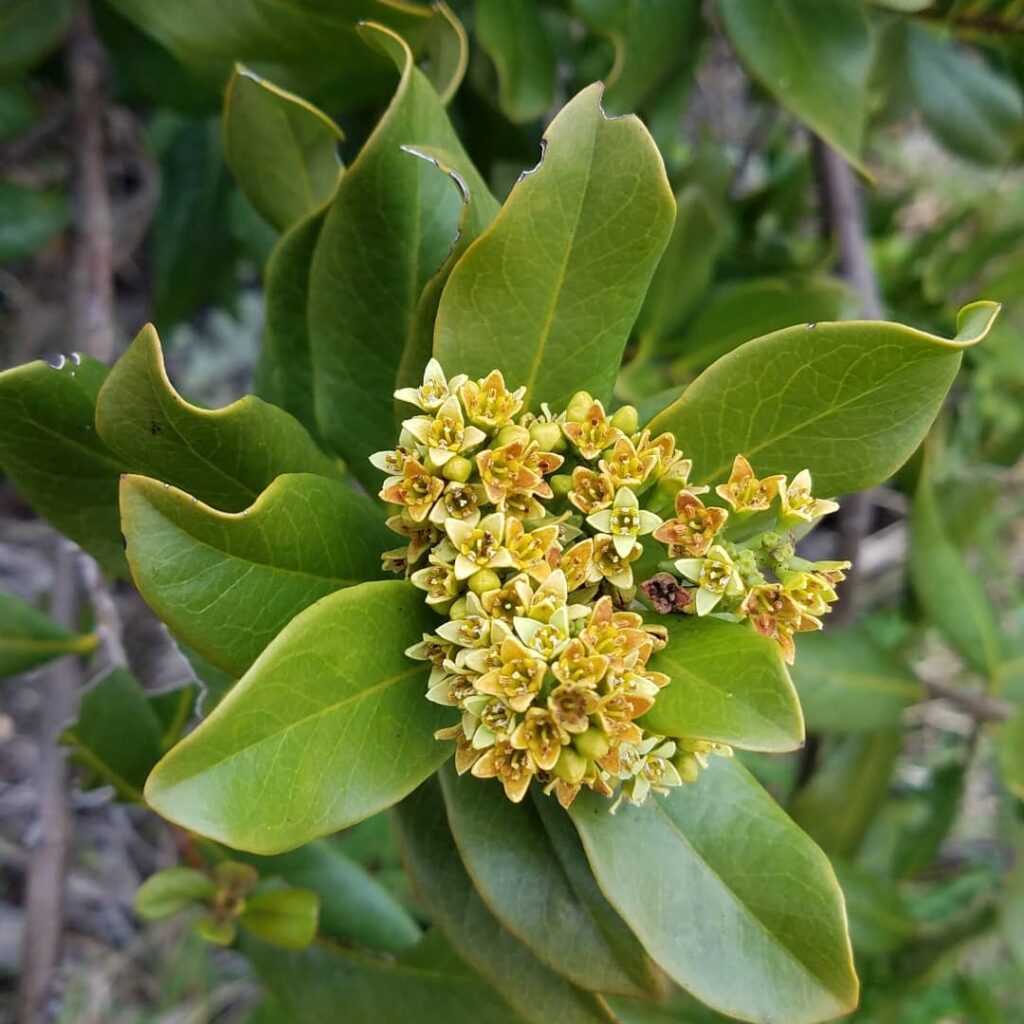
The Hawaiian Mamane (Sophora chrysophylla) is a remarkable endemic shrub or small tree belonging to the pea family, distinguished by its bright yellow, pea-like flowers and compound leaves. This hardy native thrives across diverse Hawaiian ecosystems, from dry shrublands to wet forests, reaching elevations up to 2,900 meters.
As a nitrogen-fixing species, mamane plays a significant ecological role in Hawaii’s high-elevation dry forests, particularly as the primary food source for the critically endangered Palila bird. Its durable wood has been treasured by Native Hawaiians for centuries, used in construction, tools, and religious ceremonies, while its flowers served medicinal purposes. The plant’s growth form varies dramatically with environment, appearing as short and bushy specimens in dry shrublands while developing into lanky trees on O’ahu.
- Hardiness: USDA zones 9-11; tolerates temperature fluctuations from sea level to subalpine conditions
- Light: Full sun to partial shade; adaptable to various light conditions across elevation gradients
- Water: Drought tolerant once established; moderate water needs, adapted to both dry and mesic conditions
- Soil: Well-draining soils; tolerates poor, rocky, volcanic soils; pH adaptable
- Fertilizer: Low requirements due to nitrogen-fixing capability; benefits from phosphorus in poor soils
- Pest/Disease Resistance: Generally resistant to pests and diseases; susceptible to damage from feral ungulates
- Growth Rate: Slow to moderate; variable growth form depending on elevation and site conditions
Hawaiian Ohe Naupaka Shrub
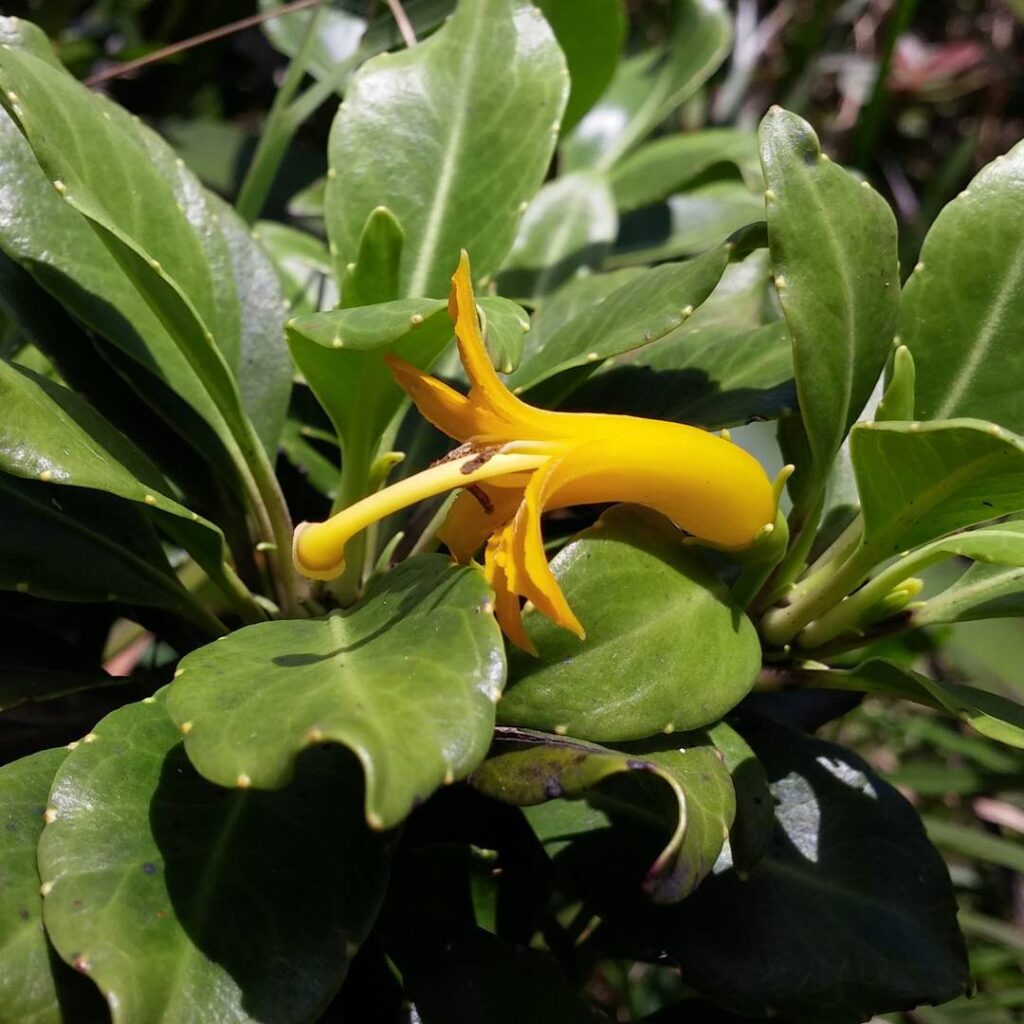
The Hawaiian Ohe Naupaka (Scaevola glabra) is a distinctive native understory shrub that can reach up to 12 feet tall, making it one of the larger naupaka varieties in Hawaii’s forest ecosystems. This evergreen member of the Goodeniaceae family features the characteristic half-flower blooms in bright yellow, creating an unmistakable fan-like appearance that blooms primarily from January through March.
As an integral component of Hawaii’s lowland forest understory, ohe naupaka serves as a vital bridge between the forest canopy and ground flora. Its obovate, bright green leaves and upright spreading growth habit make it valuable for erosion control and habitat formation. The shrub produces drupaceous fruits that provide food for native birds and pollinators, while its adaptable nature allows it to thrive in various microclimates from shaded woodlands to partly open areas. Naupaka belongs to the Goodenia family with over 130 species worldwide.
- Hardiness: Hawaiian tropical zones, adapted to lowland forest conditions
- Light: Full sun to partial shade, thrives in understory environments
- Water: Drought-tolerant once established, moderate water needs
- Soil: Well-drained, slightly acidic soils preferred
- Fertilizer: Low maintenance, minimal fertilizer requirements
- Pest/Disease Resistance: Generally resistant but vulnerable to invasive species impacts
- Growth Rate: Moderate growth rate, reaching up to 12 feet at maturity
Hawaiian Akoko Shrub (Euphorbia)
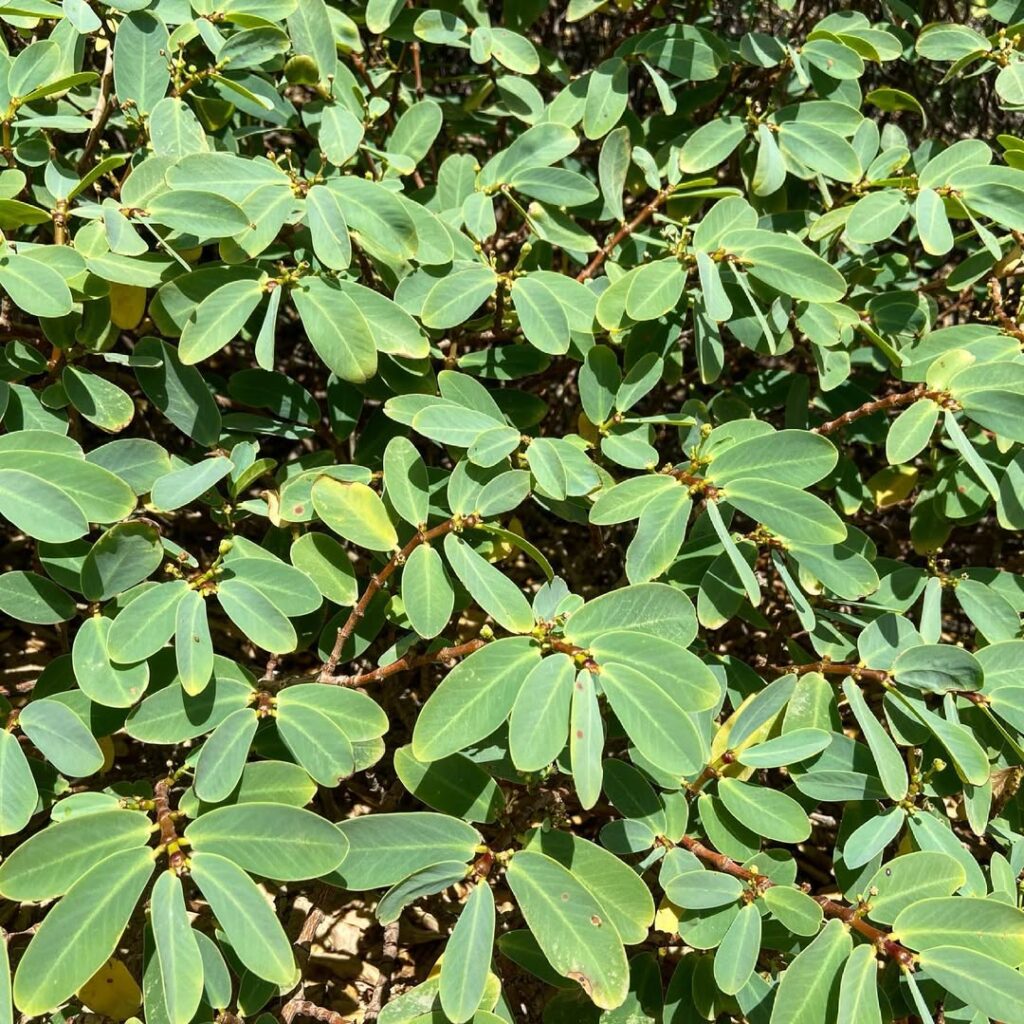
The Hawaiian Akoko shrub (Euphorbia celastroides) is a distinctive native perennial that can reach up to 2 meters in height. This highly variable species features segmented, brittle branches with gray to brown bark and small silvery-gray to green oval leaves. The plant contains milky white sap and drops its leaves during drought as a survival mechanism.
Found across all main Hawaiian Islands, akoko grows in diverse habitats from coastal areas to mountain regions. Some varieties like var. kaenana are federally endangered with only 500 specimens remaining. The Ewa Plains variety (Euphorbia skottsbergii var. skottsbergii) is particularly rare, with an estimated population of around 200 plants distributed across just 150 acres on Oahu. Historically significant to Hawaiian culture, the plant was used medicinally and its sap served as canoe paint.
- Hardiness: Adapted to tropical Hawaiian climates, drought-tolerant once established
- Light: Full sun to partial shade, thrives in open dry sites
- Water: Low to moderate water needs, extremely drought-tolerant, drops leaves during dry periods
- Soil: Well-draining soils, adaptable to various soil types from coastal to montane conditions
- Fertilizer: Low fertility requirements, adapted to nutrient-poor native soils
- Pest/Disease Resistance: Generally hardy with good natural resistance as native species
- Growth Rate: Moderate growth rate, reaching up to 2 meters at maturity
Selecting the Right Native Plants for Your Garden
How do you choose native Hawaiian plants that’ll actually thrive in your specific garden conditions? Start with native plant selection basics by considering moisture needs, since different species require varying care levels. The Oʻahu Plant Guide StoryMap helps beginners navigate xeriscape gardening options effectively.
Match plants to your elevation and island location. Upper-elevation species like Rubus macraei won’t work everywhere, being endemic to specific islands. Consider maintenance requirements too, since some plants like ho’awa have challenging propagation needs.
Focus on versatile options like ‘a’ali’i or alahe’e for reliable results. Both offer attractive foliage and adapt well to common-sense horticulture practices. Many Hawaiian species face endangered status, making responsible cultivation especially important for conservation efforts.
Frequently Asked Questions
How Do Hawaiian Native Plants Survive Volcanic Soil Conditions?
You’d think volcanic soil would kill everything, yet Hawaiian plants thrive through remarkable volcanic adaptation strategies. You’ll find they’ve mastered efficient nutrient absorption using specialized roots and symbiotic relationships with soil microbes.
What Role Do Native Birds Play in Hawaiian Plant Pollination?
You’ll find Hawaiian honeycreepers like ʻIʻiwi display specialized bird behavior as they pollinate ʻŌhiʻa lehua trees. These pollinator relationships sustain native ecosystems, with co-evolved beak shapes matching flower structures perfectly for efficient pollen transfer.
Are Hawaiian Native Plants Resistant to Invasive Species Threats?
Hawaiian native plants generally aren’t resistant to invasive species threats due to limited evolutionary defenses. However, you’ll find native plant resilience improves through functional diversity and strategic invasive species management approaches.
How Has Climate Change Affected Hawaiian Native Plant Populations?
Climate change has devastated Hawaiian native plant populations through severe habitat loss and dangerous temperature fluctuations. You’ll find over 90% of species facing reduced suitable habitats, with many retreating upslope until they can’t climb higher.
Can Hawaiian Native Plants Be Grown Successfully Outside of Hawaii?
You’ll discover something surprising about Hawaiian natives – many can thrive beyond their island home. With proper growing conditions and careful selection, you’re tapping into remarkable plant adaptability that defies geographical boundaries.
